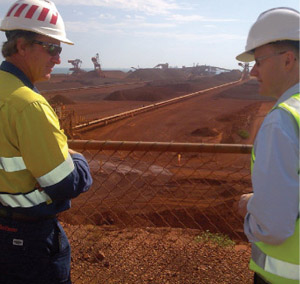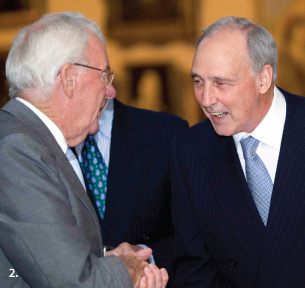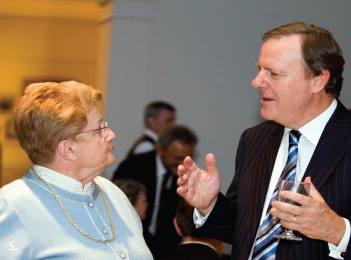Reserve Bank of Australia Annual Report – 2010 The Reserve Bank in the Community
The Reserve Bank's 50th Anniversary
The Reserve Bank opened for business as Australia's central bank on 14 January 1960 (with the Reserve Bank Act 1959 having separated the central banking and commercial functions of the Commonwealth Bank). The 50th anniversary of the Reserve Bank provided a special opportunity for greater engagement with the community. The Bank hosted a sequence of international meetings in Sydney to mark the anniversary, including a symposium that addressed central banking lessons learned over the past 50 years and the challenges ahead. The papers and proceedings were published online and a commemorative volume has also been published. A special anniversary monograph by Professor Selwyn Cornish of the Australian National University, The Evolution of Central Banking in Australia, was published in January and is available to interested readers. There were several exhibitions at the Bank's Head Office designed to share the Bank's cultural holdings with the public and provide insights into the place of financial institutions and events in the nation's history. Later this year, in recognition of the anniversary, the Research Library will re-open in a refurbished condition as the A.S. Holmes Library, in memory of one of the most influential officers to serve in the Reserve Bank in its 50-year history, Austin Stewart Holmes, OBE. It is a modest but fitting tribute to Holmes' pursuit of intellectual excellence and public service.
Activities of the State Offices
In addition to its Head Office located in Sydney, the Reserve Bank has offices in Melbourne, Brisbane, Adelaide and Perth. These offices play an important role in the Bank's business liaison program and form a key component of the Bank's communication with members of the public, business, government and academia in their respective states.

Western Australia
Since 2001, the Reserve Bank has devoted significant resources systematically to building relationships across a broad cross-section of the business community, with a view to gaining first-hand insights into conditions in different industries and regions within the national economy. The staff involved in the business liaison program have built up a pool of over 1,500 regular contacts around the country, with information from liaison meetings reported in detail to Head Office and incorporated in the material prepared for monthly Board meetings and in the quarterly Statement on Monetary Policy. In this way, information obtained from liaison is used as a complement to standard sources, such as data from the Australian Bureau of Statistics and business surveys, in forming the Bank's assessments of the economy.






Staff in the State Offices also play a role in the Reserve Bank's efforts to keep the public informed of its evolving views on the economy. They interact with a broad cross-section of the community, regularly giving presentations on economic developments to business groups, community organisations and educational institutions, in both state capitals and regional centres. They also facilitate regular visits by senior staff from Head Office's Economic Group to meet with liaison contacts and provide briefings on the economy to various groups in the community.
Liaison with Small Businesses
The Reserve Bank continues to convene its Small Business Advisory Panel. This panel was established in 1993 and meets annually to discuss issues relating to the provision of finance and the broader economic environment for small businesses. Membership of the Panel is drawn from a range of industries across the country. The Panel represents a useful source of information on the financial and economic conditions faced by small businesses.
Museum of Australian Currency Notes
The Reserve Bank's Museum contains a permanent collection as well as periodic displays, and held several exhibitions in the past year associated with the Bank's 50th anniversary. The permanent collection exhibits the story of Australia's banknotes against the background of the nation's broader history. It displays the types of money used before Federation, ranging from a rum bottle used in early colonial days to Australia's first gold coins. Visitors then view the various banknotes produced since the first Australian note series in 1913–1915. The final stage of the Museum focuses on Australia's polymer banknotes, including information on their design, security features and potential for recycling. When viewing the collection, visitors can observe the evolution of Australian identity as expressed through Australia's currency, learn about the men and women represented on the banknotes and the artwork used in their design. The banknotes are presented alongside displays of key episodes in Australian history captured in archival film, photographs and documents.
The Reserve Bank's 50th anniversary was marked by exhibitions that explored aspects of the progress of the nation through the records held in the Reserve Bank's archives. One exhibition, ‘Hidden History of Banking’, displayed convict banking records and was used to show the progress of convicts to citizens who made significant contributions to society so that they became represented on the nation's banknotes. Another exhibition, ‘Reflections of Martin Place’, included historic photographs from the Bank's collection covering landmark financial events in Martin Place; these photographs were displayed on the façade of the Head Office building during the year. And finally, there was a display of the early artworks and interior design commissioned by Governor HC (‘Nugget’) Coombs, who was committed to modernism and progress.
Nearly 13,000 people visited the Museum in 2009/10, including around 1,500 visitors on Australia Day 2010, which was a record daily attendance with many visitors attracted by the anniversary displays. Attendance was also boosted by the Reserve Bank's participation in History Week. The Museum remains popular with school groups, with many of these groups receiving a short presentation on the role of the Bank or, in the case of senior economics students, a talk on the Australian economy. Most of the information in the Museum is on the Bank's website, which was redesigned in 2010; there were around 570,000 page views/downloads of information from the Museum site in the past year, with around one-third of users of the site being from other countries.
Assistance for Research and Education
The Reserve Bank sponsors Australian and international economic research in areas that are closely aligned with its primary responsibilities. This sponsorship includes financial support for conferences, workshops, data gathering, journals and special research projects, and encompasses areas of study such as macroeconomics, econometrics and finance. In addition, the Bank provides financial support for the research activities of the Sydney Institute and the Centre for Independent Studies.
In 2009/10, the Reserve Bank continued its longstanding contribution towards the cost of a monthly survey of inflation expectations undertaken by the Melbourne Institute of Applied Economic and Social Research at the University of Melbourne, and a quarterly survey of union inflation and wage expectations undertaken by the Workplace Research Centre at the University of Sydney.
The Reserve Bank continued to provide financial support for the International Journal of Central Banking, the primary objectives of which are to disseminate first-class policy-relevant and applied research on central banking and to promote communication among researchers both inside and outside central banks. The Bank continued its support of the International Accounting Standards Committee Foundation, with the last of three pledges following completion in 2005 of the initial five-year support plan, and also its longstanding practice of contributing to the Group of Thirty's program of research and publications in the area of international finance.
Financial assistance to Australian universities each year includes contributions towards the costs of their organising conferences in economics and closely related fields. In 2009/10, these conferences included the 22nd Conference for PhD Students in Economics and Business, held at the University of Western Australia; the Economic Society of Australia's 38th Conference of Economists, held at the University of Adelaide; the 21st Annual East Asian Seminar on Economics – ‘A Pacific Rim Perspective on the Financial Crisis’; the 15th Melbourne Money and Finance Conference; the Australasian Meeting of the Econometric Society, held at the Australian National University; the University of New South Wales 22nd Australasian Finance and Banking Conference; the Financial Integrity Research Network PhD Tutorial and the Paul Woolley Conference, both held at the University of Technology, Sydney; the National Honours Colloquium and the 5th Annual Workshop on Macroeconomic Dynamics, both at the University of New South Wales; a conference focusing on econometrics and applied time series in honour of Professor Adrian Pagan; and the Asia Pacific Group's Money Laundering Conference. The Reserve Bank is also continuing to support a research project on real-time forecasting, convened by Professor Shaun Vahey of the Australian National University.
The total value of support offered for research and education in 2009/10 was $250,000.
The Reserve Bank sponsors an annual essay competition across Australia designed to engage and support undergraduate students of economics. The competition is organised jointly with the University of New South Wales Economics Society. In 2009, the theme of the competition was ‘Policy Responses to the Global Financial Crisis’. Madeline Ehler (University of Queensland) wrote the winning essay, the runner-up was Richard Swain (University of Sydney) and the best essay from a first-year student was written by Varun Chhabra (University of New South Wales). These students were presented with their prizes by the Governor at a ceremony in October. For the 2010 competition, students have been invited to submit an essay on the theme of ‘Australia's Real Exchange Rate’.
In conjunction with APRA, the Reserve Bank has continued sponsorship of the Brian Gray Scholarship Program, initiated in 2002 in memory of a former senior officer of the Bank and APRA. Two scholarships were awarded under this program in 2010, one for PhD studies at the Australian Centre for Economic Research on Health at the University of Queensland, and the other for Honours studies for Bachelor of Commerce and Finance and Bachelor of Laws and Legal Practice at Flinders University. The cost to the Bank of these scholarships in 2009/10 was $12,500.
The Reserve Bank has a rich archive of records that relate not only to the Reserve Bank, but to banking activities in Australia. Archival records have been inherited from other financial institutions, with some dating back to colonial settlement. Furthermore, as part of the Commonwealth Bank and then as Australia's central bank, the Reserve Bank was for some time the government printer for materials other than banknotes. Consequently, in addition to documents, the Bank's archives contain an historical collection of Australian stamps, vouchers and posters that are of interest to researchers. Over the past year, the Bank hosted visitsby numerous researchers interested in its archives (including academics, heritage architects, curators and postgraduate students). It also dealt with many written requests from researchers that required Bank staff to access archival records, and it has provided access to its archives by members of the public making specific enquiries. Research was conducted by Professor Selwyn Cornish, the Reserve Bank's Historian since 2007, for the monograph to mark the Bank's 50th anniversary, The Evolution of Central Banking in Australia. Professor Cornish also continued research on a further volume of the official history of the Bank covering the period 1975–2000.

Charitable Activities
During the year the Reserve Bank made its eighth annual contribution of $50,000 to the Financial Markets Foundation for Children, of which the Governor is Chairman. In July 2010, in its fifth public event to raise funds, the Governor addressed the Anika Foundation, which was established in 2005 to support research into adolescent depression and suicide.
The Reserve Bank's corporate philanthropy program involves two major initiatives: dollar-matching staff payroll deductions to the Reserve Bank Benevolent Fund; and donating the value of leave days given up by staff to work for charitable organisations under a Volunteer Day Program. In addition, in late 2009 the Bank matched the donations raised by Reserve Bank staff who participated in the ‘Sydney to the Gong’ charity bike ride. The Bank's contributions under these initiatives in 2009/10 totalled $60,550. The Bank also facilitates staff salary sacrificing under a Workplace Giving Program.
Reserve Bank staff interacted with the community in a number of volunteering capacities in the past year, including the Cancer Council's Biggest Morning Tea fundraiser, Oxfam's Trailwalker, the Starlight Children's Foundation Starlight Day and Foodbank's corporate volunteer program.